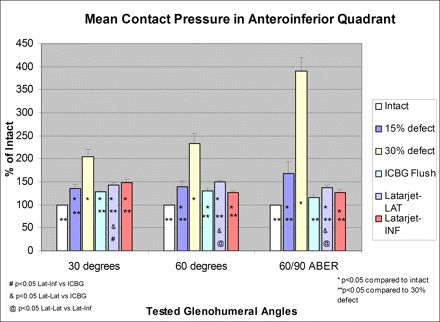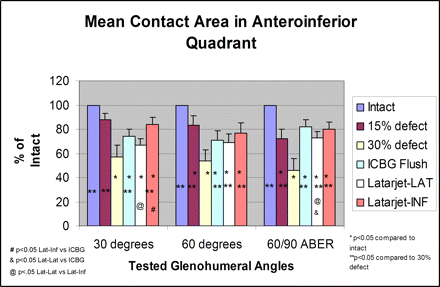Normalization of Glenohumeral Articular Contact Pressures After Latarjet or Iliac Crest Bone-Grafting
Authors: Neil Ghodadra, Aman Gupta, Anthony A. Romeo, Bernard R. Bach, Jr., Nikhil Verma, Elizabeth Shewman, Jordan Goldstein, and Matthew T. Provencher
References: J Bone Joint Surg Am. 2010;92:1478-1489
Background Multiple bone-grafting procedures have been described for patients with glenoid bone loss and shoulder instability. The purpose of this study was to investigate the alterations in glenohumeral contact pressure associated with the placement and orientation of Latarjet or iliac crest bone graft augmentation and to compare the amount of glenoid bone reconstruction with two coracoid face orientations.
Methods Twelve fresh-frozen cadaver shoulders were tested in static positions of humeral abduction (30, 60, and 60 with 90 of external rotation) with a 440-N compressive load. Glenohumeral contact pressure and area were determined sequentially for (1) the intact glenoid; (2) a glenoid with an anterior bone defect involving 15% or 30% of the glenoid surface area; (3) a 30% glenoid defect treated with a Latarjet or iliac crest bone graft placed 2 mm proud, placed flush, or recessed 2 mm in relation to the level of the glenoid; and (4) a Latarjet bone block placed flush and oriented with either the lateral (Latarjet-LAT) or the inferior (Latarjet-INF) surface of the coracoid as the glenoid face. The amount of glenoid bone reconstructed was compared between the Latarjet-LAT and Latarjet-INF conditions.
Results Bone grafts in the flush position restored the mean peak contact pressure to 116% of normal when the iliac crest bone graft was used (p < 0.03 compared with the pressure with the 30% defect), 120% when the Latarjet-INF bone block was used (p < 0.03), and 137% when the Latarjet-LAT bone block was used (p < 0.04). Use of the Latarjet-LAT bone block resulted in mean peak pressures that were significantly higher than those associated with the iliac crest bone graft (p < 0.02) or the Latarjet-INF bone block (p < 0.03) at 60 of abduction and 90 of external rotation. With the bone grafts placed in a proud position, peak contact pressure increased to 250% of normal (p < 0.01) in the anteroinferior quadrant and there was a concomitant increase in the posterosuperior glenoid pressure to 200% of normal (p < 0.02), indicating a shift posteriorly. Peak contact pressures of bone grafts placed in a recessed position revealed high edge-loading. Augmentation with the Latarjet-LAT bone block led to restoration of the glenoid articular contact surface from the 30% defect state to a 5% defect state. Augmentation of the 30% glenoid defect with the Latarjet-INF bone block resulted in complete restoration to the intact glenoid articular surface area.
Conclusions Glenohumeral contact pressure is optimally restored with a flush iliac crest bone graft or with a flush Latarjet bone block with the inferior aspect of the coracoid becoming the glenoid surface. Bone grafts placed in a proud position not only increase the peak pressure anteroinferiorly, but also shift the articular contact pressure to the posterosuperior quadrant. Glenoid bone augmentation with a Latarjet bone block with the inferior aspect of the coracoid as the glenoid surface resulted in complete restoration of the 30% anterior glenoid defect to the intact state. These findings indicate the clinical utility of a flush iliac crest bone graft and utilization of the inferior surface of the coracoid as the glenoid face for glenoid bone augmentation with a Latarjet graft.

Fig. 6 Mean contact pressure data for the anteroinferior quadrant of the glenoid at all tested angles under a 440-N load. Results are presented in relation to the intact condition. 60/90 ABER = 60 of abduction and 90 of external rotation, ICBG = iliac crest bone graft, Lat-Inf = Latarjet-INF, and Lat-Lat = Latarjet-LAT.

Fig. 7 Mean contact area data for the anteroinferior quadrant of the glenoid at all tested angles under a 440-N load. Results are presented in relation to the intact condition. 60/90 ABER = 60 of abduction and 90 of external rotation, ICBG = iliac crest bone graft, Lat-Inf = Latarjet-INF, and Lat-Lat = Latarjet-LAT.


